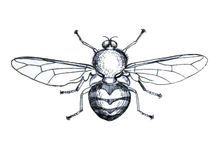Acrocerinae is a subfamily of small-headed flies in the family Acroceridae. Their larvae are endoparasites of araneomorph spiders, with the exception of Carvalhoa appendiculata which can develop as ectoparasitoids on their host spiders.[1] Traditionally, the subfamily included the genera now placed in Cyrtinae and Ogcodinae, but the subfamily in this sense was found to be polyphyletic and was split up in 2019.[1][2]
| Acrocerinae | |
|---|---|

| |
| Acrocera orbiculus | |
| Scientific classification | |
| Domain: | Eukaryota |
| Kingdom: | Animalia |
| Phylum: | Arthropoda |
| Class: | Insecta |
| Order: | Diptera |
| Family: | Acroceridae |
| Subfamily: | Acrocerinae Leach, 1815 |
| Genera | |
|
See text | |
Systematics edit
The subfamily includes two extant genera and one extinct:[1]
- Acrocera Meigen, 1803
- Carvalhoa Koçak & Kemal, 2013[3]
- †Schlingeromyia Grimaldi & Hauser in Grimaldi, Arillo, Cumming & Hauser, 2011[4]
The extinct fly genus †Burmacyrtus Grimaldi & Hauser in Grimaldi, Arillo, Cumming & Hauser, 2011[4] was originally placed in this subfamily as well, but according to Gillung & Winterton (2017) it is not considered an acrocerid.[5]
References edit
- ^ a b c Gillung, Jessica P.; Winterton, Shawn L. (2019). "Evolution of fossil and living spider flies based on morphological and molecular data (Diptera, Acroceridae)". Systematic Entomology. 44 (4): 820–841. doi:10.1111/syen.12358.
- ^ Stubbs, A.; Drake, M. (2014). British Soldierflies and their Allies (2 ed.). Wokingham: British Entomological and Natural History Society. p. 528. ISBN 9781899935079.
- ^ Koçak, A. Ö.; Kemal, M. (2013). "A nomenclatural note in the family Acroceridae (Diptera)". Centre for Entomological Studies Ankara Miscellaneous Papers (159): 3–4.
- ^ a b Grimaldi, DA; Arillo, A; Cumming, JM; Hauser, M (2011). "Brachyceran Diptera (Insecta) in Cretaceous ambers, Part IV, Significant New Orthorrhaphous Taxa". ZooKeys (148): 293–332. doi:10.3897/zookeys.148.1809. PMC 3264415. PMID 22287902.
- ^ Gillung, Jessica P.; Winterton, Shaun L. (2017). "A review of fossil spider flies (Diptera: Acroceridae) with descriptions of new genera and species from Baltic Amber". Journal of Systematic Palaeontology. 16 (4): 325–350. doi:10.1080/14772019.2017.1289566. S2CID 90493326.
Further reading edit
- Schlinger, Evert I.; Gillung, Jessica P.; Borkent, Christopher J. (2013). "New spider flies from the Neotropical Region (Diptera, Acroceridae) with a key to New World genera". ZooKeys (270): 59–93. doi:10.3897/zookeys.270.4476. PMC 3668421. PMID 23730188.
- Winterton, Shaun L.; Gillung, Jéssica P. (2012). "A new species of spider fly in the genus Sabroskya Schlinger from Malawi, with a key to Acrocerinae world genera (Diptera, Acroceridae)". ZooKeys (171): 1–15. doi:10.3897/zookeys.171.2137. PMC 3288680. PMID 22423193.